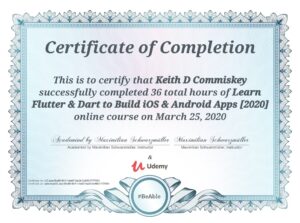Learning: Mobile App Development – via Flutter
What is … Flutter? Flutter is a mobile—and web—app development framework powered by the Dart programming language. It is akin to React Native or Ionic, and is built by Google. Dart is akin to JavaScript—but not.
Since coming out of beta in December 2018, trends from Stack Overflow and LinkedIn have indicated Flutter has become—and is currently—a well-developed, easy-to-use, community-driven framework for developing natively compiled apps. It is currently used by a variety of vendors including Square, Sonos, eBay, and of course, Google also uses Flutter to develop some of its own products such as Google Ads.
Flutter 101: The Course
Academind (Udemy; Online Education) provides over 150 high-quality courses across near two dozen topics, and is devoted to real-life success via online learning. Tagline aside, their Flutter course in point is a fine-tuned 36-hour course, and is the most detailed study program I have ever had the pleasure of going through.
Max, the instructor, goes through the course with an ever-encouraging tone, dropping tips and tricks and hints between every instruction. In fact, these tips and tricks are dropped so often, if you skip thirty seconds of instruction, you could potentially lose out on a handful of intrinsic insights that could save you hours of developmental headaches later on. Notes abound.
Due to the vast depths of shared knowledge throughout the lectures, many students have signaled their need—and desire—for going through the course multiple times. I, on the other hand, went through every minute of the course an equivalent of seven times—in one pass. Between taking copious notes on every single detail of instruction, reading through every comment in the majority of lectures—and contributing my own comments throughout, all in addition to typing through all the code—and testing—every detail, you are assured to come out the other side with at least three fully featured apps.
In the end you will have the opportunity to take one of your apps, say the “Meals” app, for instance, and upload it to either the Google Store, the Apple Store (if you have a Mac), or both.
Icing on the Cake
Two key things this course does above and beyond:
- It runs you through not-so-happy paths, (“incidentally” on purpose) and
- it helps you to understand why and how things broke.
Max provides concrete decisions on coding styles, but is also adamant and direct when a particular approach is simply “one way of doing things.” He provides a heavy emphasis on detailing how to approach any given situation in a variety of ways—providing insightful input on the pros and cons of each.
In honor of doing what you love in life and in sharing your knowledge with others, it is with pride I am able to share the Flutter course completion certificate provided by Max of Academind. I look forward to my travels down the road they helped begin to pave.
Course Completion Certificate
- Title: “Learn Flutter & Dart to Build iOS & Android Apps [2020]“
- Certificate: https://ude.my/UC-aaa10e86-9311-4dd7-8a24-3e9531777591
- Platform: Udemy: Completed: March 25, 2020; 36 hours
- Instructor: Academind by Maximilian Schwarzmuller
Flutter Learning Path Logistics
I initially went through the following two courses which ultimately led me to the course on Udemy (as they were intended to do—thankfully so).
Flutter Tutorial for Beginners → Udemy course prequel—this is basically the first section of the Udemy course, ergo, I would suggest just doing the course version, as it is likely more up to date.
- Academind | YouTube: 03:22:18 (3 days; Jan 6 – 8; 29)
- Build iOS and Android Apps with Google’s Flutter & Dart
Flutter Crash Course for Beginners 2020 → A really good intro course
- Academind | YouTube: 05:44:31 (3 days; Feb 5 – 7)
- Build a Flutter App with Google’s Flutter & Dart
Next Phase
- Building [Pragmatic] Mobile Apps
Keith D Commiskey
https://keithdc.com


